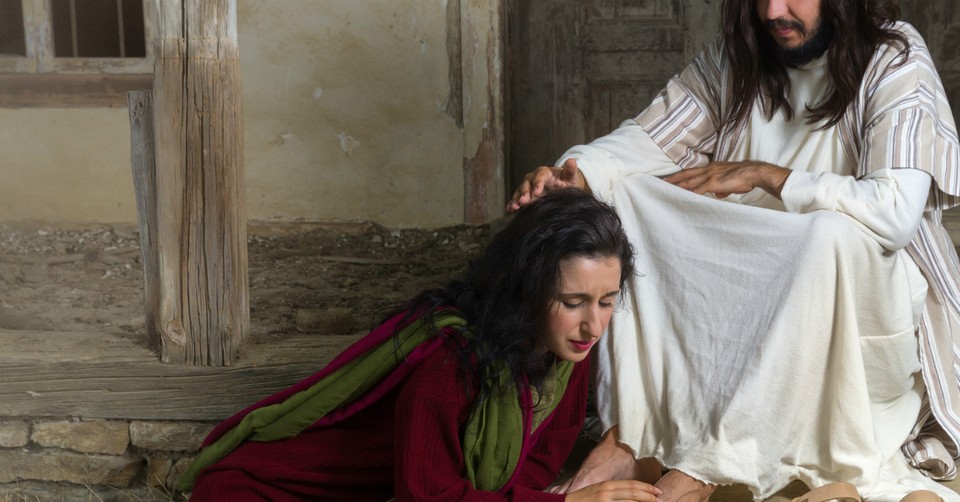How Did Jesus Treat Women?

The world that Jesus was born into largely marginalized women. Despite that, Jesus treated women as equal to men. Jesus’s countercultural regard for women was nothing short of remarkable for His day and notable for ours, depending on the part of the world you live in.
Before we can discuss Jesus’s extraordinary treatment of women, it’s important to note that Jesus’s esteem for women is rooted in God the Father’s esteem for women.
Jesus Valued Women As God the Father Did
As the second person of the Holy Trinity, Jesus’s high regard for women is modeled after God the Father’s. Throughout history, God has made His respect for women clear in bold ways. Starting in Genesis, we read the Almighty declared that He created mankind in His own image, “male and female He created them” (Genesis 1:27).
God’s profound respect for women was also front and center when He sent His angel Gabriel to the virgin who would bear God’s only Son without the involvement of a man in the conception (Luke 1:26-38).
After Jesus’s birth, God continued to emphasize the integral role of women. We see one example during Jesus’s consecration at the Temple of Jerusalem, where Mary and Joseph encountered Anna, a prophet and elderly widow. Upon seeing the infant Jesus, Anna began praising God and speaking of Jesus “to all who were looking forward to the redemption of Jerusalem” (Luke 2:36-38).
As an elderly widow, Anna would have been one of the lowest-regarded members of society in Biblical times. Despite this, God gave Anna the authority to proclaim His will as a prophet. God further blessed Anna by giving her the special knowledge to recognize Jesus as our Savior while He was still an infant.
Last, at the end of Jesus’s earthly life, God continued to exalt the role of women. We see this in the fact that the Almighty chose a woman—Mary Magdalene—to be the first witness to the most significant event in all of Christianity: Christ’s Resurrection (John 20:11-18).
Now that we’ve considered the extent to which God valued women let’s explore Jesus’s treatment of women throughout His ministry.
The Societal Status of Women in Jesus’s Day
In Jesus’s time, women weren’t allowed to enter the Temple in Jerusalem in the way that men were. Specifically, women were not to go beyond a designated boundary line in the outer court. Women were also forbidden from touching the Torah, and rabbis would not teach women how to study the sacred text.
In synagogues, women weren’t allowed to read aloud from the Torah and were generally excluded from worshipping God in ways that men were allowed to worship.
From a societal perspective, women were further treated as an oppressed class of people. Men were not supposed to greet women in public. Unmarried women lived under the complete authority of their father or another male relative if the father was deceased. Once married, women were under the absolute authority of their husband or a male relative if the husband was dead.
A woman was also not allowed to divorce her husband, although he could divorce her for any reason. A woman’s ability to own property or receive an inheritance was greatly diminished, except through a male relative. Simply put, the first-century world that Jesus was born into treated women as second-class citizens with diminished individual rights.
Jesus Upheld the Dignity of Women by Taking Them on As Disciples
Given society’s misogynistic sentiment toward women in Jesus’s day, Jesus’s interactions with women were shocking to onlookers and revolutionary in hindsight.
At a time when society regarded women as something to be disregarded at will, Jesus reminded His fellow Jews that God created women in His image in the same way that He created men in His image (Matthew 19:4).
At a time when others regarded women as unworthy company, Jesus kept close ties with Mary, Martha, and Mary Magdalene. Jesus even kept company with women who had been possessed and disease-ridden. This included Mary Magdalene, who had been cleansed of seven demons (Luke 8:2).
When others saw women as inferior intellectually, Jesus preached to Mary at His feet, the typical place for a male disciple to sit. Jesus didn’t object to Mary’s desire to learn and didn’t question Mary’s capacity to understand what He taught (Luke 10:38-42). Instead, He commended Mary for making the better choice of hearing the Teacher speak, asserting that His lessons “will not be taken away from her” (Luke 10:42).
The Gospels tell us that, aside from the women noted above, Jesus’s followers included many other women, some of whom financially supported Jesus and His Apostles (Luke 8:1-3).
Jesus Made the Most Important Revelations of His Ministry to Women
In continuing to reject cultural norms, the longest conversation Jesus had with an individual in the New Testament was with a woman - and a woman with a checkered past at that! (John 4:1-26). In particular, Jesus initiated a conversation with a Samaritan woman He encountered at Jacob’s well (John 4:7-26). For a man to address a woman in public was scandalous at the time (John 4:27).
Importantly, this Samaritan woman was also the first person to whom Jesus revealed that He was the long-awaited Messiah (John 4:25-26). This woman went on to become a missionary for Jesus, bringing others in her town to Christ (John 4:39).
In continuing to make groundbreaking revelations specifically to women, the Resurrected Christ not only appeared first to Mary Magdalene, but He also commissioned her to be the first to give testimony of His Resurrection (John 20:17-18). This fact is especially radical when you consider that women in Biblical times were seen as unreliable witnesses at best and were not allowed to testify in court.
Jesus Shows Compassion to Women Who Were Disregarded by His Jewish Community
Jesus’s esteem for the plight of women is seen elsewhere in Scripture. At Jesus’s crucifixion, His mother Mary is presumed to have been a widow. With rare exceptions, widows in ancient Israel suffered a sort of cultural death by being relegated to the fringes of society and usually ending up in extreme poverty.
As a widow, Mary may have been headed for a similar fate. However, Jesus kept His mother’s wellbeing in mind despite the excruciating pain He endured at His crucifixion. Scripture tells us that as He hung, Christ entrusted the Apostle John with Mary’s care (John 19:26-27).
We also see Jesus’s concern for the plight of disregarded women when He cured a woman who had been crippled for 18 years on the Sabbath (Luke 13:10-17). When the synagogue leader confronted Jesus for having healed the woman on the Sabbath, Jesus defiantly declared the woman a “daughter of Abraham” (Luke 13:16). In making this bold assertion, Jesus put her (and all other women) on par in Jewish society with their male counterparts, or the “sons of Abraham.”
Jesus Refused to Treat Women as Unclean or Especially Deserving of Punishment
The Jewish law in Jesus’s time had many rules as to what was considered ritually unclean. A woman was considered to be unclean if she was menstruating. As such, anyone or anything that touched her during this time was also deemed ritually impure.
Jesus, however, refused to treat women as unclean. This is dramatically played out in the Bible’s account of the woman who had been bleeding for 12 years (Luke 8:40-48). Here, Jesus was making His way through a crowd toward an official’s house to heal the official’s sick daughter when the woman with the blood disorder touched Jesus’s cloak. Such an action made Jesus unclean according to Jewish law.
Just then, Jesus stopped walking toward the official’s house and insisted that the person who had touched Him step forward from the crowd. When the trembling woman came forward and explained her actions, Jesus did not furiously admonish her for her risky, ritually impure actions. Instead, Jesus called the woman “daughter” and commended her for putting faith before man-made law (Luke 8:45-48).
Jesus further turned these purity laws on their head in the tender scene of the “sinful woman” who washed Jesus’s feet with her tears and anointed them with perfume (Luke 7:36-50). There, Christ admonished an onlooker for his concern with the woman’s sinfulness and, instead, lauded the woman for her faith and humility. Jesus also refused to condemn women that His Jewish community would have stoned as sinners. One stark example of this is the story of the woman caught in adultery (John 8:3-11). In that account, Christ dramatically stopped an imminent execution by daring any one of the women’s accusers who was free from sin to cast the first stone (John 8:7).
Jesus Expected Women to Be Personally Responsible for Their Sins
In Jesus’s even-handed treatment of women, He expected women to take personal responsibility for correcting their own sinful behavior. We see this in Jesus’s discussion with the Samaritan woman at the well when He refused to politely gloss over the woman’s lie about not having a husband. There, Christ laid bare the Samaritan woman’s sins by plainly stating that he knew she actually had five husbands and was living with another man who was not her husband (John 4:17-18, 29).
Another example of Christ viewing women as capable of answering for themselves is seen in the story of the woman about to be stoned to death for adultery. When Jesus exposed her would-be stoners for their own sins, the angry mob dispersed one by one. Jesus then turned to the woman and privately told her that she was free to go but that she was to leave her life of sin behind (John 8:11).
The Bible demonstrates that Jesus did not discriminate against women based on their sex, age, financial or marital status. Rather, Jesus recognized women as on par with men by embracing their fellowship, support, and witness. Notably, whereas rabbis of the time refused to teach women the Bible, Jesus taught the Word of God to all of His followers regardless of gender.
By defying society’s view of women as inferior, Jesus taught us through His ministry that dignity and discipleship are open to everyone, male and female alike.
Dolores Smyth is a nationally published faith and parenting writer. She draws inspiration for her writing from everyday life. Connect with her over Twitter @byDoloresSmyth.
Originally published December 01, 2021.







